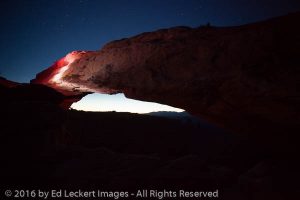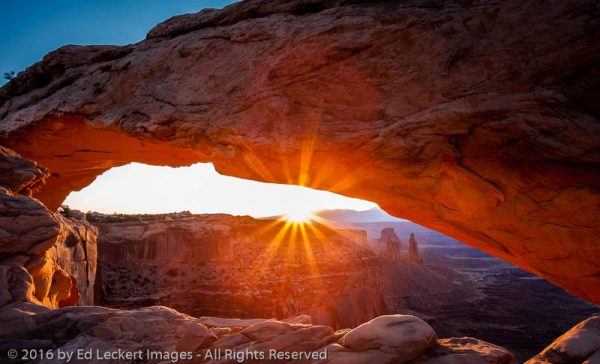


You probably think you could go hiking in a national park several hours before dawn and have the place to yourself. You could not be more wrong.
Last week in A Night in the Parks, my friend Jeremy and I began our nighttime adventures in Arches National Park photographing the Milky Way above a feature named Balanced Rock via the technique of “Light Painting”. When the Milky Way had risen too high for our purposes, we headed to Mesa Arch in Canyonlands National Park, a drive of about one hour. We had already scouted out the area two days prior and knew where we wanted to be for our dawn shoot, an important consideration when stumbling around in the dark.
As I mentioned two weeks ago in Arches and Canyonlands, the feature that makes Mesa Arch interesting at dawn is that the sandstone cliff face below it reflects a beautiful orange light up onto the base of the arch for a very short time just at sunrise. Of course this means that all the serious photographers show up at exactly the same time to capture this phenomenon, and there’s not much space there to work with.
We always try to be as courteous to other photographers as we would like for them to be to us. Even if we can’t see them in the dark, we know they must be there, based on the number of cars in the parking lot and the popularity of the place. But we also have to see where we are going, especially in an area with deadly drops to the canyon floor below. Jeremy was slightly ahead of me (as usual) and was the first to be noticed by some photographers doing astrophotography using the arch. They asked us to stay back and wait for them to finish their shots, so we extinguished our headlamps and waited.

My first test image of Mesa Arch, taken about 5:15 on the morning of our shoot, in Canyonlands National Park, Utah.
It wasn’t more than a minute or two before they finished their shooting and invited us to come forward. Nature photographers, for the most part, are considerate and polite people. We turned on our headlamps and proceeded to the area just beneath the arch where everyone gathers. After chatting with us for a while, the photographers moved on, their shooting for the night done.
I didn’t keep strict time records, but we left Balanced Rock just before 3:00 AM, so it must have been about 4:00 AM when we arrived at Mesa Arch. There were already several photographers there preparing for the dawn shoot, in addition to those on the way out. At a spot this popular, it’s all about getting the best real-estate! We quickly staked out our preferred spots, negotiating and plotting with the other photographers to protect our spaces as best we could. “Move a little closer so no one can jam in between us”, suggested the woman on my left who was planning to shoot a series of panoramic images using a “pano” head on her tripod. We maneuvered our tripods until neither was blocking the other’s intended shots. Her husband and my friend Jeremy had chosen locations more centered in front of the arch, whereas she and I were shooting farther to the right and lower to try to catch more glow from beneath the arch. Keep in mind that this was occurring when it was still pitch dark – not even a glow on the horizon yet, and our headlamps off to keep from blinding each other.
As time passed, more and more photographers arrived, including a large group of French photographers. Unfortunately, one of them found it necessary to smoke cigarettes, an act that is generally held in disdain by photographers, hikers, and other nature lovers trying to enjoy what little is left of our wilderness, including the fresh air.
As photographers arrived, it became more and more difficult to move. No one will get in front of you, but left, right, and behind you, photographers fill in any and every available space. The pros come first with their large tripods and expensive DSLRs, followed by the amateurs hand-holding their lightweight DSLRs, and finally, right as the sun is about to rise, the few tourists with their camera phones who are willing to get up and out this early. There is a definite hierarchy to this process that can be measured by arrival times!
It’s been getting lighter and lighter the whole time, and finally, the magical moment arrives, and the photographers go nuts! Shutters are firing all around me, as the experienced photographers are trying to capture a starburst effect as the sun first peaks out over the horizon. (Starbursts are easily achieved when you have a point source of light, such as when only a very tiny piece of the sun is showing, and you use a very small aperture, say, f/16 or smaller.)

The first rays of the morning sun strike the sandstone beneath Mesa Arch, reflecting a deep orange light onto the bottom of the arch, in Canyonlands National Park, Utah.
When the light got too “hot” for my tastes, I attempted to extract myself from the mob surrounding me without knocking over any tripods or hurting myself. It really was that crazy! After a few minutes of walking around, I began to get feeling back in my legs. The sunrise photographers were dispersing as the tourists began to arrive in larger numbers, ready to take their selfies, so I was able to grab my tripod and pack up.
So was it worth it? Am I happy with the result? It was definitely worth it, and I’d certainly do it again if I were in the area. As to the result, well, it’s nice, but I think it needs work. Shooting into the sun always presents challenges, and the type of lens used certainly can make a huge difference. If I had it to do over again, I would probably experiment with sunburst effects using different lenses before going out on the shoot. I would move left and try the spot Jeremy shot from, even though it’s higher because of a rock formation in the way. And I would probably bracket more, and plan on blending multiple exposures for the final result. And, of course, the weather changes and the sun’s position changes throughout the year, so I would study other photographs of the spot and see how the position of the sun affects the result.
So that’s it for Mesa Arch – it’s time to move on to the next shoot – but not until next week!
